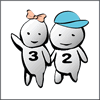
Learning to Read VisuallyIn the last section, I defined "learning to read mentally." Essentially, I told you it means learning language skills by memorizing. Or through "parroting," to be more visually exact. What kinds of things are children asked to memorize? Pretty much every basic language skill there is, from the alphabet, to the sounds we use to construct our words. These letters, and sounds, together form the basis of all of our language skills. Speaking of sounds, do you know what experts call the sounds which make up a language? They call them, "phonemes." And phonemes are the basic building blocks of all words, even the words you hear in your head. Now to get an idea of how important these chunks of sound really are, go back for a minute to your unabridged dictionary. Now page forward from the beginning until you find a page on which they've written the "pronunciation key." Did you notice where, in the dictionary, this page occurs? It occurs, of course, at the very beginning. Why? Because it is the key to how each and every word in the whole dictionary sounds. Every word. Pretty important, yes? What is also important is that this list of letters, and how they are pronounced, is a good example of a language skill children normally learn through memorization. Sadly, because memorizing is how children are asked to learn this information, most people never really retain these "keys," let alone see the beauty in them. And if you want to understand why they never retain them, picture the following. Why Memorization is TemporaryPicture an etch-a-sketch pad, you know, the rectangular toy on which children can draw or write and afterwards, erase what they've written by lifting the plastic sheet on which they wrote. I picture mine being light gray plastic with a light gray sheet of plastic film on which to write. Now picture yourself writing the whole pronunciation key on this screen. Yes I know he pronunciation key is complex and so, this will you take a long time. Even so, picture yourself doing this, slowly and carefully, copying everything you see in the dictionary pronunciation key list to your etch-a-sketch pad screen. Now picture yourself done. And proud of yourself. And you should be. You just worked hard. Now consider that I ask you to memorize something new, something like the "eight times table." What do you have to do now? You must, of course, make room for this new information. How? By lifting the plastic page on your etch-a-sketch pad. Unfortunately, as soon as you do, you lose all your hard work. But what the heck. You have no other choice. There is simply no other way to write the new information. This process very much resembles what happens when we "memorize" information. How so? Whenever we memorize, we write whatever information we want to remember on our mind's short term memory screen, a sort of one page mental scratch pad. Unfortunately, because this mental screen has only one page, in order to memorize any new information, we have to first clear away any old information. In the case you have just pictured, then, wherein you wrote out pronunciation key, this means all the work you just did would have to be erased. This is how learning by memorization works. Memorization uses a temporary, single-page screen of the mind which you must erase every time you need to remember new something new. How is Learning by Visualization Different?How is learning by visualization different? For one thing, when you learn by visualization, you use an area of the mind which has unlimited screens. This means nothing you put there ever has to get erased. In fact, scientists tell us this is actually true. So what happens when you add visual information to what you already know? Whenever you add new visual information, what you add gets amended onto what was already there. The point? Our minds store what we visualize permanently. So if what we visualize gets stored in our minds permanently, why can't we access all this information? We can't access it all because visual learning is state dependent. In other words, in order to access what we saw, we must first be in the state of being we were in when we first recorded the information. Why? Because along with the visual information we record there we also record what we felt as we watched this information. In a way, then, this experiential information is sort of like the time code that gets recorded beneath every frame of a movie. It is also how our minds index what we see. Thus, similarly to how we must be on an index page in order to read what's on it, we must be on our mind's experiential index page. How do we do this? We do this by visualizing where and when we first learned the information. In what state? In the sate we were in when we first learned, when we were babies and before we knew words. Elsewhere on the site, I refer to being in this state as being in "baby consciousness." Literally, it is the same state in which we lived and learned in for the first several years of our lives, our primary learning state. This state is also the state in which we learn visually. And also the state in which we experience learning as fun. So What Do Children Learn When Asked to Memorize the Pronunciation Key?So what do children learn when asked to memorize the pronunciation key? They learn how to temporarily mimic these sounds and even then, only when necessary, such as when their grades depend on this. Other than in these times, though, pretty much no one pays attention to this list of sounds, including English teachers. Do most children ever genuinely learn this key then? Not really. In fact, see for yourself. How many ways can you pronounce an "A" in English? Most dictionaries list either three or four. Now actually try doing this. Without looking, how many ways can you pronounce an "A?" Now a confession. As I was writing this article, I realized, I did not know this information either. In fact, the only time I can ever remember even looking at a pronunciation key was a few years back when I became curious about foreign languages, especially those with a different alphabet, such as Greek and Russian. What I realized from doing this was, learning any language begins pretty much with the same two tasks; learning to write the letters of the alphabet, and learning to speak the sounds these letters represent. Why then do I not know a single English-speaking person who can actually list the English pronunciation keys from memory. Not even half the list. Not even a small part of this list. But can knowing these keys really be as important as I'm making it sound? It is if you want to read out loud with confidence. Or learn from a dictionary. Or speak to your boss or to another professional. It's also important if you want to write a letter or a paper for school. Why? Because editing what you write requires that you pronounce these words in your head. Thus, even in your head, you can hear words confidently or not. OK. Reading out loud. Yes. Speaking to your boss? OK. Writing papers? Yes. But dictionaries? Yes. Dictionaries. In fact, although most people do not use dictionaries regularly, these books are supposed to be our reference guides to even to our native tongue. And again, where in the dictionary are the alphabet and the pronunciation key listed? Both are always found in the same place. They are found at the beginning. If this is the case, then, and if understanding a language begins with these two things; with the alphabet and with a pronunciation key; why, then, do so few people ever learn both? How, in fact, can we be overlooking something this important? Learning by Rote is BoringI think we overlook it because most of us have been asked to learn pronunciation keys by rote, which is simply yet one more way to refer to learning by memorizing. Further, because everything we learn by memorizing gets erased, learning anything by rote is a royal pain in the butt. And boring. Necessary though? Yes, at times. But boring none the less. What is really important to note here is, because most people find this way of learning boring, most of us memorize only what we need to in order to be able to pass tests. And since the pronunciation key is not something on which we normally get tested, few, if any of us learn it let alone retain any of it. So here are my questions. Would young children be better off learning this key right along with the alphabet? Could young children even be taught this information? And if so, is there a better way we could be teaching children the pronunciation key? Would young children be better off learning this key right along with the alphabet? I think this is a necessity. Could young children even be taught this information? I believe so. Yes. Is there a better way we could be teaching children the pronunciation key? Again, I believe so. What follows, then, are my suggestions for how children could be taught the pronunciation key. As you might guess, my suggestions, like those I've offered for teaching the alphabet, are visual. Try reading these suggestions. Then, see for yourself how they've affected you. How? By seeing if you don't find yourself wanting to learn more about the pronunciation key. I did. And if you do too, perhaps young children would feel this desire as well. 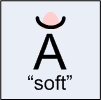
A Visual Pronunciation KeyIf you look up at the image I've placed above, what you'll find is a modified version of the first "A" in my dictionary's pronunciation key. As you can see, there is a bowl shaped curve above this "A." What does this "bowl" represent? One the four ways English speakers can pronounce this letter. At least, according to this dictionary. Thus, in this dictionary, this "A," which some people call the "soft" "A," has an up-turned curve above it to indicate this is the"A" we use when we say the word, "hat." "Hat." Of course, no dictionary uses anything like the little pink shape I've added above the "bowl" shaped line. Why have I added this? To make this pronunciation key guide mark resemble a "hat." Why make this mark more complicated than it already is? Because making anything into a recognizable shape makes it easier to learn. And easier to remember. Visual learning, remember. So now, for just a moment, imagine you are seven, and that you are sitting in a semi-circle of seven year olds facing me and a blackboard. Imagine too that today, I will be teaching them, and you, all about dictionaries and about what they can teach you. You hear me ask, "Who can tell me what they can learn from a dictionary? Of course, someone says, "You can learn how to spell words." Then, someone adds, "... and learn what those words mean." Then someone really smart says, " You can sometimes also learn where the word came from; its original language and what it first meant." "Hmm mm," some say, and a murmur goes through the group. Then no one speaks. Why? These three things are all we usually know to use a dictionary for; [1] spelling; [2] meaning; and [3] origin. "What about number 4?" I ask. " "What's number 4?" "Pronunciation." "Pronunciation!," everyone yells laughing. "Yuck!" Now, can you picture children actually responding this way? Of course you can. And yet, if you picture a child in a classroom who has been asked to read out loud, you get an immediate sense of how important pronunciation really is: Most kids struggle with it terribly. In fact, I'd bet most adults have the same or similar feelings. Most people dread it. Is this dread really necessary though? Isn't there a way to teach pronunciation wherein learning to pronounce words becomes fun? Yes, there is. Visual learning, remember. Now let's look at what learning the pronunciation key could look like, if we were taught it visually, in a way in which learning it was fun. 
"Word Families Wear the Same Hat"So there it is again, the soft "A," the "A" with the curved line above it. Already, I'd bet you can tell me what it sounds like, just from what I've told you already. If you've forgotten, allow me to remind you. It's the "A" we say when we say the word, "hat." Now I'll let you in on a secret. First, take a look at the shape of the hat above this "A." Now the secret. You can always tell which family of "A" sounds an "A" belongs to by looking at the shape of the hat it wears. For instance, the "A's" who wear soft hats all sound alike. Want to see? I've placed a family photo of the soft "A" family below. 
Notice they're all wearing the same hat. Except of course, for the "A" in "also." Somehow a spotted hat "A" snuck in there, just like people sometimes sneak into other peoples' family photos. Except for old spotted hat though, all these "A's" wear the same hat. This means they all talk like each other, meaning they all sound similar just like real people do in real people families. So what other hats can "A's" wear? Well, let's see. There are four all together. I've drawn the second "A" hat below. 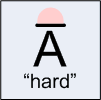
...and this "A" sounds like the "A" in "hay. And in "pay." And in "today." And if you want to see what this "A's" family photo looks like, I've placed it's family photo below. 
And what about the third "A?" 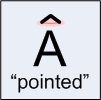
This is the "rare- bare- hare" "A." And the "caring mare" "A." This "A's" family photo is next. 
And the fourth "A?" The fourth "A" is the "A" we say when we say the word, "ha!" And "pa." And "ma." And "father." And all these "A's" wear the same family hat too. They all wear hats that looks like this. 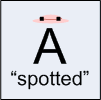
Finally, this fourth family of "A's" is pictured below. 
Sound like a lot to learn? Yes, it is. But what if you had been seeing these "hats" since you were five or so. Do you think you would have trouble pronouncing "A's?" I doubt it. Lastly, to show you how easy it could be to learn about letter "A" hats, I've placed a photo of all four below. In it, I've lined up all of the hats on a shelf in a"A" kindergarten cloakroom. 
Final Words on "Hats"Obviously, what I've just introduced would take a lot of work to design. And to put into practice. Even so, how much work is it to go through a whole lifetime being afraid you'll mispronounce a word? In truth, then, despite the fact that many of us cringe when asked to read out loud for fear we'll mispronounce a word, most of us never realize how important this key is let alone that if we knew it, we could read with confidence. Why do we not realize this? Because we do the same thing we when we were did back in school. We, like our teachers, avoid being in these situations as much as we can. Now do me a favor. See if you've forgotten which hat the "A" in "hat" uses. Try it. I doubt you have. It, of course, wears the first "hat," which by now you know is called, the "soft" hat. There is, of course, one final test to see if all this really works. The test? Ask yourself, now, if you feel at all curious as to how many hats "E's" can wear. And "I's." And O's." And U's." A hint. Fourteen hats in all. Now can you guess which of these letters wears the most "hats?" For this answer, you'll have to wait 'till another time. Unless, of course, you now feel drawn to go get your dictionary and see for yourself. If you do, please do. Oh, and one more thing. Just in case someone out there tells you there are more than four ways to pronounce an "A," know that they are right. Almost, anyway. You see there are four ways to pronounce an "A" as a letter "A." However, there are also times when a letter "A" is pronounced like another letter, for instance like an "O" with a pointed hat. Thus the "A" in words like "awl," "talk," "audio," and "awful" is written as a letter "A" but spoken like a pointed-hatted letter "O." And if we were to want to teach children this, you might show them something like the little drawing I've drawn below. 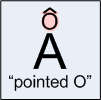 And just in case you are interested, here's what some of the rest of this family looks like: 
|
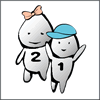
.